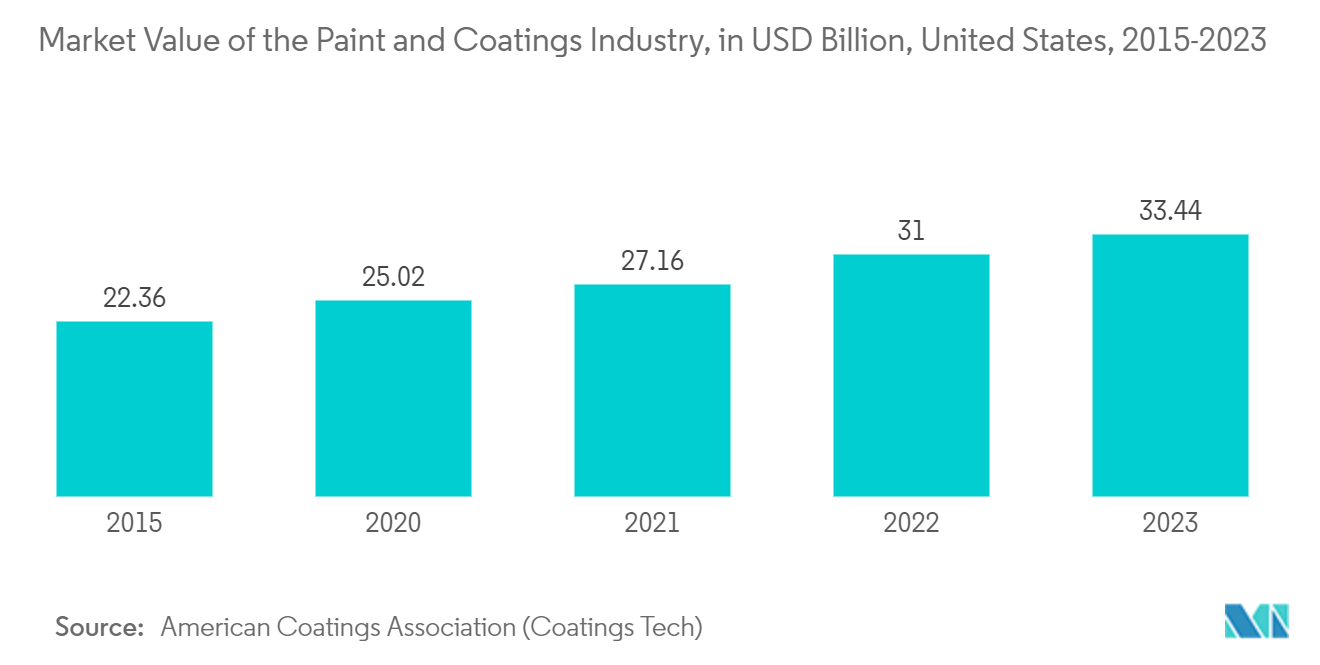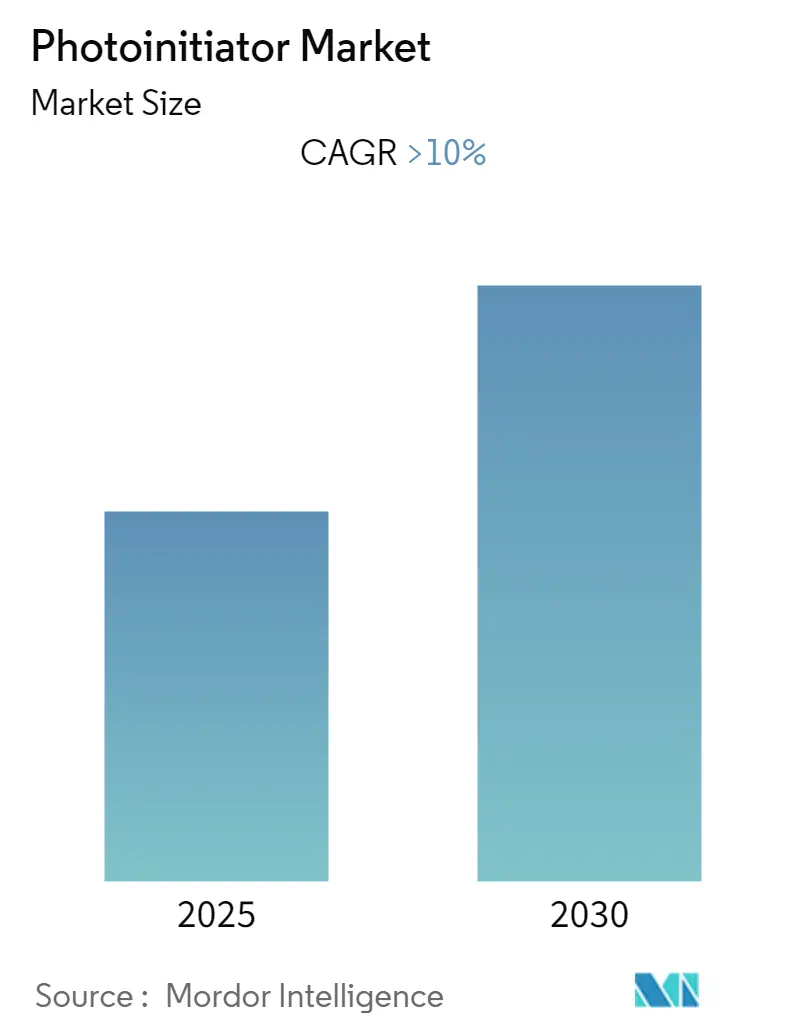
| Study Period | 2019 - 2030 |
| Base Year For Estimation | 2024 |
| Forecast Data Period | 2025 - 2030 |
| CAGR | 10.00 % |
| Fastest Growing Market | Asia-Pacific |
| Largest Market | Asia-Pacific |
| Market Concentration | Low |
Major Players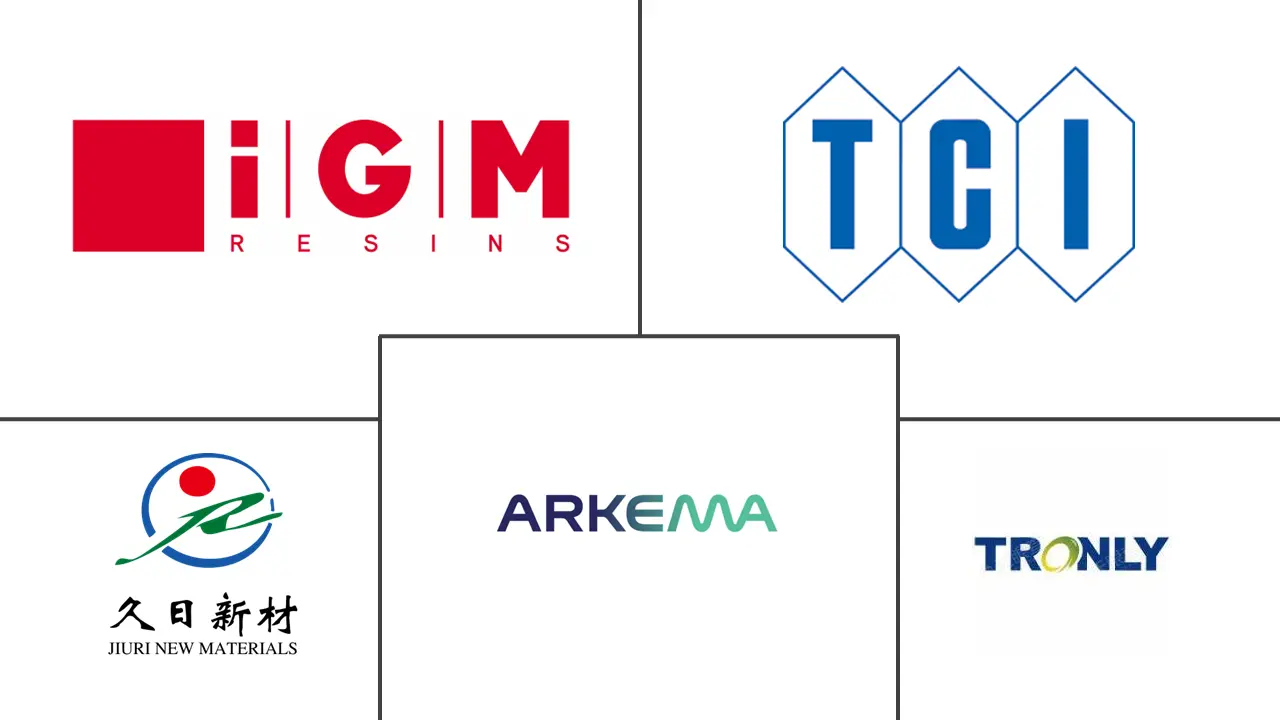
*Disclaimer: Major Players sorted in no particular order |
Photoinitiator Market Analysis
The Photoinitiator Market is expected to register a CAGR of greater than 10% during the forecast period.
The COVID-19 pandemic negatively impacted the market for photoinitiators. Major market participants are from Asia-Pacific and Europe, among the most hit by the viral pandemic. Revenue for the companies fell from 7% to 10% in 2020 compared to the previous year. The diminishing gains deterred new entrants into the photoinitiators industry and adopters in their work processes. The photoinitiator market recovered from the pandemic and is growing significantly.
- Over the short term, with promising growth in end-use industries such as adhesive, coating, ink, and paint along with eco-friendly alternatives for volatile organic compounds (VOCs) as photoinitiators may be dissolved in water using oligomers, producing little or no environmental impacts on the applications are projected to fuel market growth throughout the forecast period.
- However, safety concerns, as the photoinitiators' production necessitates the toxic chemicals used for human health and high prices. They are the significant factors likely to hamper the photoinitiator market size growth.
- Nevertheless, creating non-hazardous photoinitiators for use in the dentistry industry will likely create lucrative delivery opportunities for the market over the forecast period.
- Regarding revenue, Asia-Pacific is expected to dominate the global market during the forecast period.
Photoinitiator Market Trends
Coatings Segment to Dominate the Market
- A photoinitiator is a molecule that creates reactive species (free radicals, cations, or anions) when exposed to radiation (UV or visible). Synthetic photoinitiators are vital components in photopolymers (i.e., photo-curable coatings, adhesives, and dental restoratives).
- During the forecast period, the coatings sector will likely have the largest photoinitiator market share. Photoinitiator coatings are gaining popularity for coating applications in the medical, electronics, carpentry and woodworking, and automotive industries.
- The growing application of photoinitiators to produce displays, flexible electronics, aerospace, automotive, solar batteries, and fuel cells will further expand the segment's growth.
- According to the American Coatings Association (Coatings Tech), the market value of the paint and coatings industry in the United States was over USD 31 billion in 2022. The industry is expected to reach a market value of around USD 33.4 billion in 2023.
- According to Arkema, from 2021 to 2026, Asia was predicted to have the largest CAGR in the coatings industry, at 6%. In terms of value, Asia had the largest coatings market in the world in 2021.
- According to Bostik, a renowned adhesive producer, the Asia-Pacific adhesives and sealants industry is expected to develop the most over the next five years, with nations such as China, India, and Japan being the key growth drivers. With the increased need for packaging items in the FMCG and e-commerce industries, India and China saw significant demand for adhesives between 2020 and 2021.
- All the above factors are expected to drive the coatings segment, enhancing the photoinitiators' demand during the forecast period.
Asia-Pacific Region to Dominate the Market
- Asia-Pacific region is forecast to hold a larger share during the forecast period. The Asia Pacific region is home to several leading players, including Zhejiang Yangfan New Materials Co., Ltd, IGM Resins, and Adeka Corporation. Besides, the growing population will also bolster the demand for paint & coating, leading to the growth of the photoinitiator market share.
- China is well-known for its industrialization and manufacturing sector, which rely heavily on paints and coatings. Automotive, industrial, and construction are some of the critical areas in which paints and coatings are employed in the nation.
- China controls more than a quarter of the worldwide coatings market. According to the China National Coatings Industry Association, the industry increased by 7% recently.
- PPG announced the completion of its USD 13 million investment in its Jiading, China, paint and coatings facility in May 2021, which included eight new powder coating production lines and an expanded powder coatings technology center. It is expected to improve PPG's research and development capabilities. The expansion will enhance the plant's capacity by over 8,000 metric tons annually.
- Grasim Industries (Aditya Birla Group) announced plans to invest INR 10,000 crore (USD 1,370 million) in its paint industry by FY 2025 in May 2022. Previously, in January 2021, the firm announced intentions to invest INR 5,000 crore (USD 685 million) in the paints sector over the following three years. By Q4 FY2024, the business expects to have a paint facility up and running with a capacity of 1,332 million l per year (MLPA).
- According to the Ministry of Economy, Trade, and Industry (Japan), the production volume of synthetic resin paints in Japan in 2021 will be roughly 1.01 million metric tons, representing a massive paint manufacturing volume. Overall, the production volume of paints rose to almost 1.53 million metric tons in 2021, compared to 1.50 million metric tons in 2020.
- According to the Ministry of Economy, Trade, and Industry (METI), the volume of gravure inks produced in Japan in 2021 would be roughly 121.86 thousand metric tons. In addition, planographic ink output in Japan was expected to reach 67.29 thousand metric tons in 2021.
- According to Statistics Malaysia, the country's printing ink output accounted for 28.72 kilotons in 2021, compared to 35.33 kilotons in 2020, resulting in a decrease in pigment consumption from the printing ink category.
- IGM Resins bought Litian, a renowned Chinese maker of energy-curing resins, in July 2022. IGM currently offers three unique product lines due to the acquisition. It is a world-leading variety of photoinitiators, a substantial supply of energy-curing resins, and a decent selection of additives.
- Thus, all the above factors will likely increase the demand for the photoinitiator market during the forecast period.
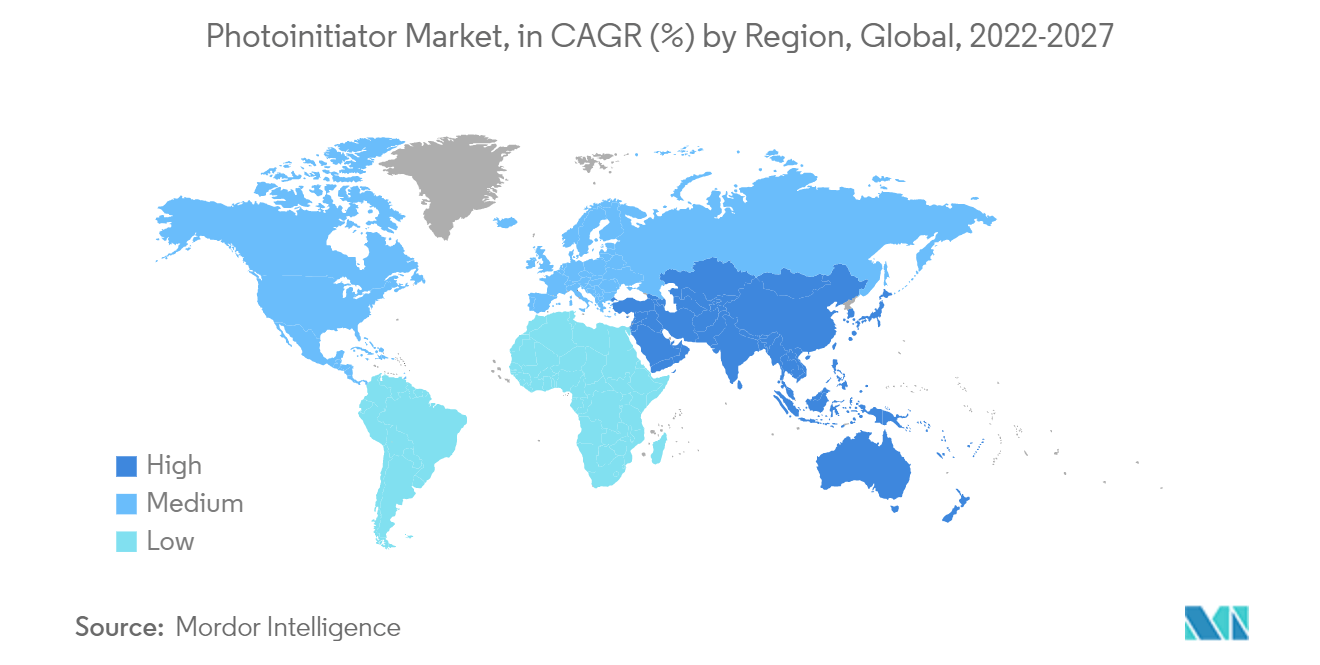
Photoinitiator Industry Overview
The photoinitiator market is fragmented in nature. Some of the major manufacturers in the market include Arkema, IGM Resins, TCI Chemicals, Tianjin Jiuri New Material Co. Ltd., and Changzhou Tronly New Electronic Materials, among others (in no particular order).
Photoinitiator Market Leaders
-
Arkema
-
IGM Resins
-
TCI Chemicals
-
Tianjin Jiuri New Material Co. Ltd.
-
Changzhou Tronly New Electronic Materials
- *Disclaimer: Major Players sorted in no particular order
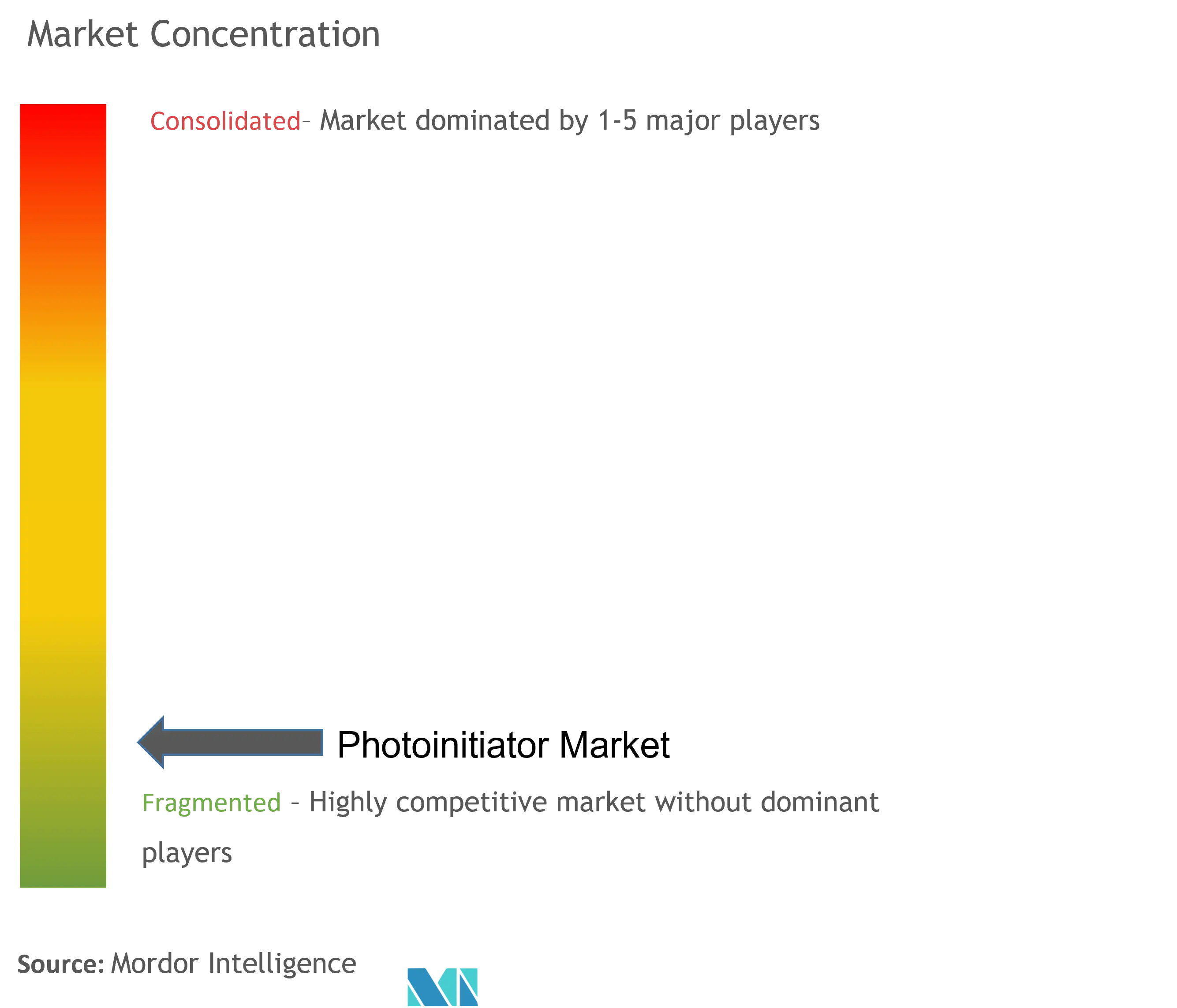
Photoinitiator Market News
- July 2022: IGM Resins acquired Litian, a Chinese manufacturer of energy-curing resins. After the acquisition, IGM now includes three distinct product lines, a wide range of photoinitiators, a strong offering of energy-curing resins, and a good selection of additives.
- May 2022: Arkema exhibited novel and more sustainable solutions like resins, photoinitiators, and 3D printing materials at RadTech UV+EB 2022 in Orlando, FL. During eight technical conferences, Arkema technical specialists showcased their most recent advancements in energy-cured materials.
Photoinitiator Industry Segmentation
A photoinitiator is a molecule that creates reactive species when exposed to radiation. Synthetic photoinitiators are critical components in photopolymers. Some small molecules in the atmosphere can also act as photoinitiators by decomposing to give free radicals. The photoinitiator market is segmented by type, application, and geography. By type, the market is segmented into free radical and cationic. By application, the market is segmented into adhesives, ink, coating, and other applications. The report covers the market size and forecast for the photoinitiator agent market in 15 countries across major regions. For each segment, the market sizing and forecasts have been done based on value (USD million).
| Type | Free Radical | ||
| Cationic | |||
| Application | Adhesives | ||
| Ink | |||
| Coating | |||
| Other Applications | |||
| Geography | Asia-Pacific | China | |
| India | |||
| Japan | |||
| South Korea | |||
| Rest of Asia-Pacific | |||
| North America | United States | ||
| Canada | |||
| Mexico | |||
| Europe | Germany | ||
| United Kingdom | |||
| France | |||
| Italy | |||
| Spain | |||
| Rest of Europe | |||
| South America | Brazil | ||
| Argentina | |||
| Rest of South America | |||
| Middle-East and Africa | South Africa | ||
| Saudi Arabia | |||
| Rest of Middle-East and Africa | |||
Photoinitiator Market Research FAQs
What is the current Photoinitiator Market size?
The Photoinitiator Market is projected to register a CAGR of greater than 10% during the forecast period (2025-2030)
Who are the key players in Photoinitiator Market?
Arkema, IGM Resins, TCI Chemicals, Tianjin Jiuri New Material Co. Ltd. and Changzhou Tronly New Electronic Materials are the major companies operating in the Photoinitiator Market.
Which is the fastest growing region in Photoinitiator Market?
Asia-Pacific is estimated to grow at the highest CAGR over the forecast period (2025-2030).
Which region has the biggest share in Photoinitiator Market?
In 2025, the Asia-Pacific accounts for the largest market share in Photoinitiator Market.
What years does this Photoinitiator Market cover?
The report covers the Photoinitiator Market historical market size for years: 2019, 2020, 2021, 2022, 2023 and 2024. The report also forecasts the Photoinitiator Market size for years: 2025, 2026, 2027, 2028, 2029 and 2030.
Our Best Selling Reports
Photoinitiator Industry Report
Statistics for the 2025 Photoinitiator market share, size and revenue growth rate, created by Mordor Intelligence™ Industry Reports. Photoinitiator analysis includes a market forecast outlook for 2025 to 2030 and historical overview. Get a sample of this industry analysis as a free report PDF download.



